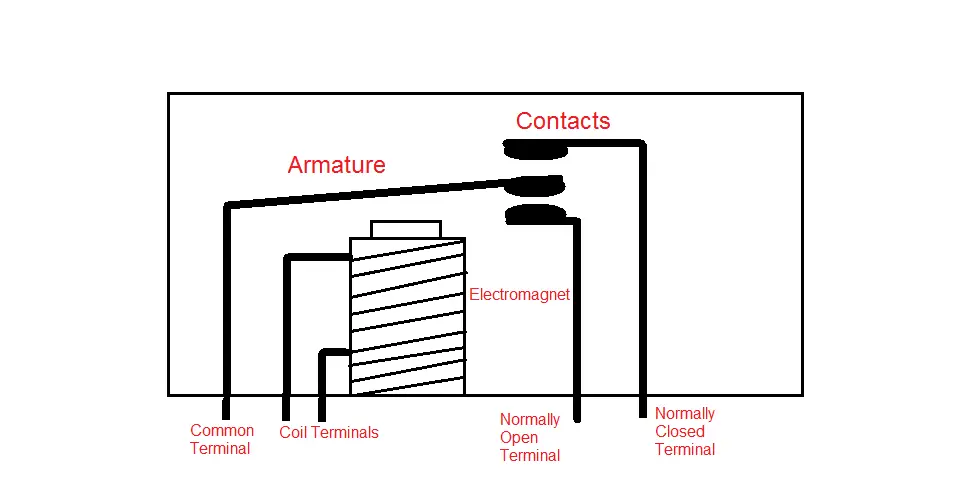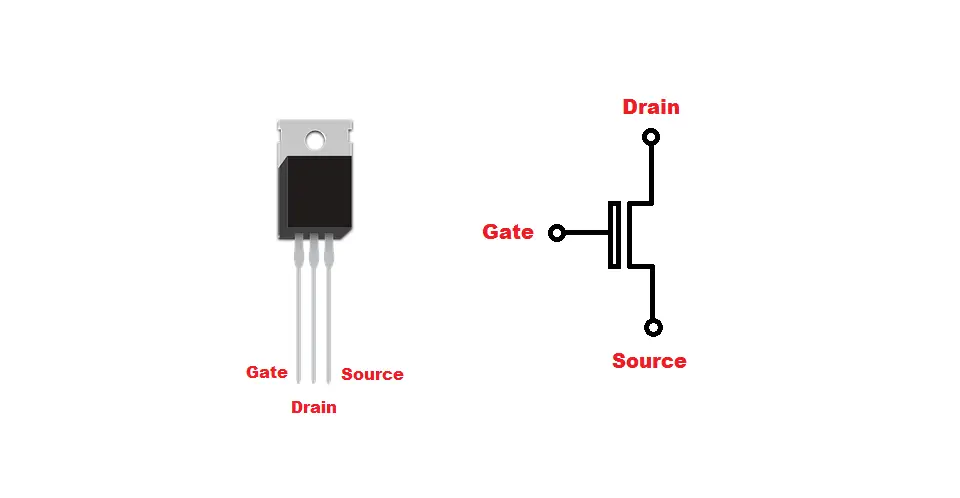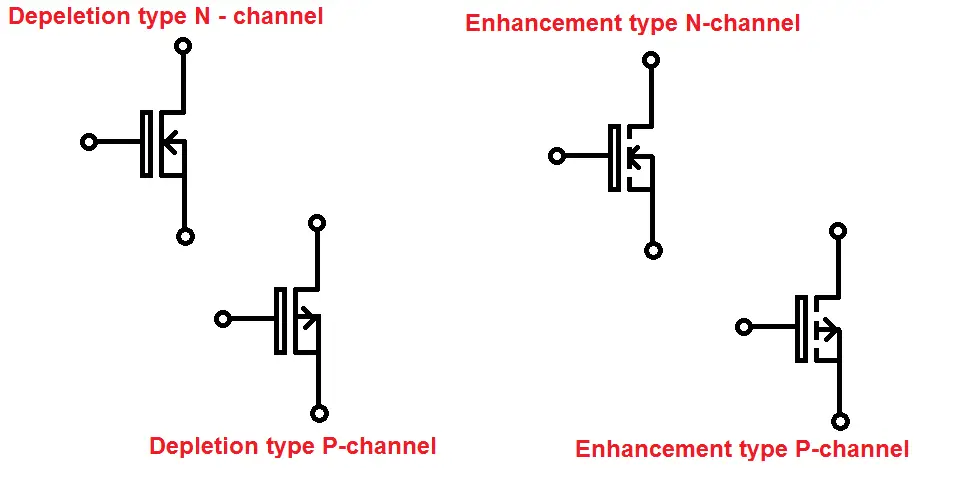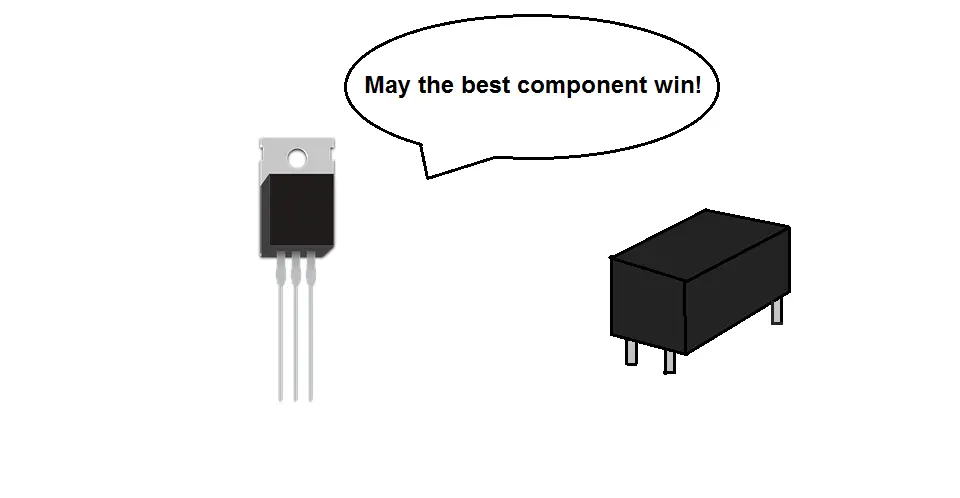There are many times when you will be faced with options and be confused as to the differences, or which might be the better option for your situation.
Every option however, will have its own advantages and disadvantages.
The two options at the centre of this article are a MOSFET and a Relay.
So, MOSFET vs RELAY, which is the better option?
There are many considerations to examine when pondering the above question. While both have a similar purpose, they do have their differences.
This article shall take a closer look at the MOSFET and Relay, and their differences to see which might be best suited for a particular application compared to another.
Deeper look at a MOSFET and Relay
Before we can put the MOSFET and Relay head to head, it will benefit us if we first learn a bit more about each component (it will be brief).
If you are already well versed about each component, you can skip this section.
What is a Relay?
Since the relay came first, we can start our journey with it.
There are many applications where a logic circuit of low current controls an output circuit which is subject to higher currents.
In these scenarios it is important to isolate the control circuit from the output as the large currents could damage the logic circuit.
This is where the Relay comes to the rescue.
A relay is a device that operates like a connection between two circuits of different current levels. Relays control one electrical circuit by opening and closing its contacts in another circuit
They essentially convert a small input current into a high output current.
Earlier relays were electromechanical which meant that there was physical contact when they were opened and closed.
However, as with most things, the relay evolved and now comes in a Solid-State version which does the switching with no physical contact (everything is achieved electronically).
But one is not better than the other as each has its own purpose for the needs of certain applications (a discussion for another day).
When comparing the MOSFET and Relay, we shall concentrate on the earlier electromechanical version of the relay.
Relay construction and working principle
If we were to open up a relay and break it down, we would be able to separate it into four major components which include;
- Frame
- Coil
- Armature
- Contacts
Frame – this is part of the relay that encompasses and supports the other parts
Coil – has the main function of pulling the armature by means of a magnetic field (the armature returns to its original position by means of a spring after the magnetic field is removed).
Armature – the main moving part of the relay which has contacts to the ends.
Contacts – part of the relay that provides a physical path for current to flow.
Relays consist of two circuits, an energising circuit which is connected to the control circuit, and a contact circuit which is where the output gets connected.
When the coil of the relay is energized, a magnetic field is generated thus pulling the armature which closes the circuit of the output allowing current to flow.

What is a MOSFET?
Transistors are semiconducting devices that can be used either to amplify or switch electrical signals.
The MOSFET is part of the family of transistors which shares the same purpose as its peers. But, the way it goes about doing so is different.
Furthermore, it is a subset of another commonly used transistor, the Field Effect Transistor (FET).
MOSFET stands for Metal Oxide Semiconducting Field Effect Transistor.
It is a three terminal device which includes a Gate(G), Source (S), and Drain(D).

There are two main two groups of MOSFET (Enhancement and Depletion),which can either be N-Channel or P-Channel. This gives us four types of MOSFET seen below;
- Enhancement Mode N-Channel
- Enhancement Mode P-Channel
- Depletion Mode N-Channel
- Depletion Mode P-Channel

The main purpose of a MOSFET
MOSFETs have a wide variety of uses , but ultimately they were created with one specific purpose, to act as an electrical switch.
A mechanical switch is a device used for making or breaking a connection within an electric or electronic circuit.
When the switch is ‘OPEN’, no current can flow through the circuit. The circuit is said to be ‘OFF’.
When the switch is ‘CLOSED’, current can now flow through the circuit powering whatever load is connected. The circuit is said to be ‘ON’.
A MOSFET functions in a similar fashion, but does so electrically.
When a MOSFET is in the cut-off region, no current can pass through it (just like a switch when it is OPEN).
But, when it is in the saturation region, current can freely flow (just like when a switch is CLOSED).
So, in the cut-off region it is effectively OPEN inhibiting the flow of current, and in the saturation region it is CLOSED allowing the current to flow just like a switch.
However, the MOSFET has greater capability than a normal switch. It also has the ability to isolate high currents in its output from low current circuits at its input.
What do MOSFETs and Relays have in common?
While a MOSFET and Relay have many differences, they do have one thing in common which is to provide isolation between low current and high current circuits.
They act as a ‘switch’ allowing for a small current at the input to control a larger current at the output.
Differences between a MOSFET and Relay
So, the MOSFET and Relay share a common goal. However, while their goals might align, the way they go about achieving them varies.
This section shall discuss the key differences between MOSFETs and Relays.
Let’s take a look.
Difference #1 between a MOSFET and Relay: Output Current Limit
The first major difference between a MOSFET and Relay is the output current limit.
Both devices have many important characteristics and none more so than the amount of current that they can handle at their output.
There are many devices that can be connected at the output of MOSFETs and Relays. Devices such as motors, lights, speakers etc.
Depending on the complexity of the device, as well as its size, it will require a certain amount of current to operate.
Bigger devices will require higher current levels to operate. MOSFETs and Relays will need to be able to handle these high currents without failure.
When it comes to output current limits, Relays have a higher current limit compared to MOSFETs making them more suited for high current applications.
Difference #2 between a MOSFET and Relay: Isolation
The main purpose of both devices is to provide isolation between the input and output circuits. The input circuits deal with lower current levels than the output.
As we just saw, the magnitude of current at the output can be quite large. If this current has a path to the input, all components on the input side will be damaged.
So, it is important for both the MOSFET and Relay to have Isolation between the input and output circuits.
Relays provide complete electrical isolation compared to MOSFETs further making them a better option for high current applications as these currents have no path to the input.
Difference #3 between a MOSFET and Relay: Cost
Money is a big factor when it comes to engineering projects. You might be given the task of designing and creating a certain circuit and are only allotted a fixed amount of money.
It will be beneficial to you to be able to choose the cheapest components (without sacrificing quality of course), so that you have enough money to buy all necessary parts.
If the application you are designing for requires the ability of the MOSFET or Relay, but you are strapped for cash, the relay is a better option as it tends to be cheaper.
Difference #4 between a MOSFET and Relay: Active vs Passive
Electrical and electronic components can be split up into two categories; Active and Passive.
Active components have the ability to produce power in the form of voltage or current, while Passive components do not have the ability to produce power but rather store power in the form of voltage or current.
The next difference is that a MOSFET is an active device, while a Relay is passive.
Difference #5 between a MOSFET and Relay: Linear vs Non-Linear
Just like whether a component is active or passive, they can be further divided up into whether they are Linear or Non-Linear.
Linear components have a steady change in current as a changing voltage is applied to them. The flow of current changes linearly.
On the other hand, the flow of current through Non-linear components does not happen linearly with a changing voltage across them (hence why they are called non-linear).
In this instance, MOSFETs are non-linear devices, while Relays are linear.
Difference #6 between a MOSFET and Relay: Switching times
If you were to close and open a mechanical switch, there is going to be a delay. You will not be able to switch between the two states instantaneously.
This is true for the switching of MOSFETs and relays as well.
The times of how long it takes to switch-on and switch-off MOSFETs and relays is known as switching times.
Switch-on times tell us the delay before current starts flowing, while switch-off times tell us the delay when current stops flowing.
Due to no moving parts in MOSFETs, their switching times are faster compared to relays.
Also, due to their mechanical nature, relays have issues with contact bounce associated with the mechanical contacts.
Difference #7 between a MOSFET and Relay: Lifetime
How long something lasts is of great importance no matter what area you might be discussing. It would suck if your car only lasted a year before you had to buy a new one.
The same holds true for components in the electrical world.
The longer they can last the better!
Now when it comes to the lifetime of a MOSFET vs a Relay, due to the fact that the MOSFET has no moving parts, it has an increased lifetime as opposed to a relay.
As you can imagine, the physical movement within the relay is going to generate a lot of wear and tear greatly reducing its lifetime.
Difference #8 between a MOSFET and Relay: Size
Another important parameter that needs to be taken into consideration when designing circuits is Size.
The application might demand the need for a compact circuit and enclosure. If the physical dimension of the printed circuit board decreases, you are going to have less space to play with.
If you are able to find components of smaller physical size this will benefit you.
MOSFETs are notably smaller in size compared to relays.
MOSFET vs Relay ; Which is the better option?
So we have just covered the notable differences between a MOSFET and Relay.
But, when we put them head to head, is one better than the other?
The simple answer is no, one device is not better than the other. This is because there are a myriad of electrical and electronic applications each with their own unique needs.
And a MOSFET or a relay will not be able to meet the needs of every particular application.
For example, if an application will be subject to large amounts of current, and switching needs to be done at relatively low speeds, a relay is the perfect candidate.
However, if now the application requires high switching speeds, and current is moderate, a MOSFET is the perfect option.
So you see, it really depends on the application’s needs.
Also, MOSFETs and relays are not always interchangeable.





